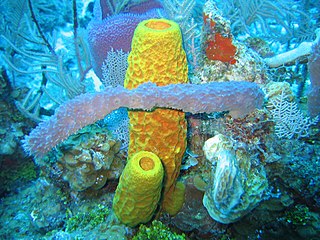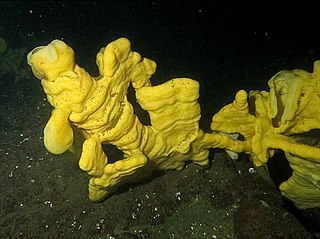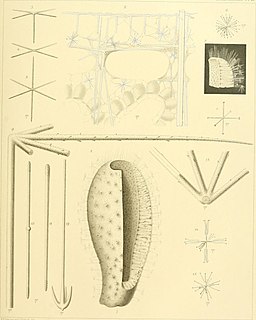Related Research Articles

Demosponges (Demospongiae) are the most diverse class in the phylum Porifera. They include 76.2% of all species of sponges with nearly 8,800 species worldwide. They are sponges with a soft body that covers a hard, often massive skeleton made of calcium carbonate, either aragonite or calcite. They are predominantly leuconoid in structure. Their "skeletons" are made of spicules consisting of fibers of the protein spongin, the mineral silica, or both. Where spicules of silica are present, they have a different shape from those in the otherwise similar glass sponges. Some species, in particular from the Antarctic, obtain the silica for spicule building from the ingestion of siliceous diatoms.

The siliceous sponges form a major group of the phylum Porifera, consisting of classes Demospongiae and Hexactinellida. They are characterized by spicules made out of silicon dioxide, unlike calcareous sponges.

The cloud sponge(Aphrocallistes vastus) is a species of sea sponge in the class Hexactinellida. It is a deep-water reef-forming animal. The species was first described by F.E. Schulze in 1886.

Spicules are structural elements found in most sponges. The meshing of many spicules serves as the sponge's skeleton and thus it provides structural support and potentially defense against predators.

Turonia is an extinct genus of sea sponges belonging to the class Demospongiae.

Rossellidae is a family of glass sponges belonging to the order Lyssacinosa. The family has a cosmopolitan distribution and is found at a large range of depths.
Vetulina is a genus of sea sponges in the subclass Heteroscleromorpha. It is the only genus in the monotypic family Vetulinidae and the monotypic order Sphaerocladina.
Protomonaxonida is an extinct order of sea sponges. It is a paraphyletic group gathering the most ancient species from the Burgess Shale to modern sponges.

Amphidiscosida is an order of hexactinellid sponges characterized by amphidisc spicules, that is, spicules having a stellate disk at each end. They are in the class Hexactinellida and are the only order classified in the monotypic subclass Amphidiscophora. Species of the order Amphidiscosida have existed since the Ordovician period, and still flourish today.

Coeloptychium is an extinct genus of lychniscosidan hexasterophoran sea sponge which has often been used as an index fossil. Its remains have been found in Cretaceous sediments in Germany, Belgium, France and the UK. Coeloptyhcium is best preserved in Campanian sediments in Germany. The type species, C. agaricoides, was named in 1826.

Lophoptychium is an extinct lychniscosidan hexasterophoran sea sponge which is a subgenus of Coeloptychium. Its remains have been found in Santonian-Maastrichtian-aged deposits in Germany and Poland. The type species, L. lobatum, was originally named as a species of Coeloptychium in 1826 but it was moved to a separate subgenus in 1872.
Sceptrulophora is an order of hexactinellid sponges, commonly known as Glass sponges, characterized by sceptrule spicules, that is, "microscleric monactinal triaxonic spicules that include clavules with terminel umbels or smooth heads." Species of the order Sceptrulophora have existed since the Jurassic period, and still flourish today. While there is ongoing debate about the organization of various taxa in Sceptrulophora, the monophyly of the taxon Sceptrulophora is supported by the presence of sceptrules in most of the extant species, and has recently been further supported by DNA sequencing.

Farreidae is a family of glass sponges in the order Sceptrulophora.

Euretidae is a family of glass sponges in the order Sceptrulophora.

Aspidoscopulia is a genus of glass sponge in the family Farreidae.
Claviscopulia is a genus of glass sponge in the family Farreidae.
Jean Vacelet is a French marine biologist who specialises in the underwater fauna of the Mediterranean. After earning his licence at the Faculté des Sciences de Marseille and learning to dive in 1954, he specialised in the study of sponges at the Marine station of Endoume, and there he has stayed faithful to both sponges and place for more than half a century. His research has included all aspects of sponges: taxonomy, habitat, biology, anatomy, their bacterial associations, and their place in the evolution of multi-celled animals. He has studied them not only in the Mediterranean but in the Indian Ocean and the Pacific. Exploration of underwater grottoes, together with Jacques Laborel and Jo Hamelin, revealed the existence of sponges dating from very ancient geological periods and the unexpected existence of carnivorous sponges, and surprisingly, the grottoes in some ways mimicked life at much greater depths.

Theonellidae is a family of sponges belonging to the order Tetractinellida, which was first described by Robert von Lendenfeld in 1903.
Diapleuridae is a family of five extinct species of marine glass sponges found in the Caribbean Sea, Florida Straits, Banda Sea, and US Virgin Islands. A sixth species–Diapleura hatoni–is postulated to have existed around the same time as the other five, but there is limited research on it. Diapleuridae is part of class Hexactinellida and order Lyssacinosida. These sponges lived during the Middle Epoch of the Eocene and were filter feeders that were attached to the benthos by a basal disc. The oldest recorded fossil of a species of Diapluridae is from 47.8 million years ago, with the most recent fossil dated 41.3 million years ago.
References
- ↑ R. M. Finks, R. E. H. Reid, and J. K. Rigby. 2004. Porifera (Demospongea, Hexactinellida, Heteractinida, Calcarea). Treatise on Invertebrate Paleontology Part E, Revised E(3):1-872 [W. Kiessling/W. Kiessling/W. Kiessling]
- ↑ "Myrmecioptychium Schrammen, 1912". www.gbif.org. GBIF . Retrieved 2020-09-04.
- ↑ "Fossilworks: Coeloptychium (Myrmecioptychium)". fossilworks.org. Fossilworks . Retrieved 17 December 2021.
- ↑ "Transitory level of modular organization in the Late Cretaceous hexactinellids (Porifera)". ResearchGate .
- ↑ A. Schrammen. 1912. Die Kieselspongien der oberen Kreide von Nordwestdeutschland, Teil 2 Triaxonia (Hexactinellida) [Upper Cretaceous sponges from north-western Germany, part 2 Triaxonia (Hexactinellida)]. Palaeontographica, Supplement 5:176-385